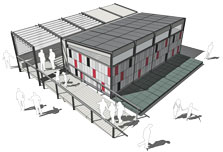

The Cincinnati home takes advantage of the sun with two south-facing walls: first a "fence" of solar thermal collectors enclosing the courtyard and then an all-glass wall for the living area.
Download Construction Drawings
(Zip 7 MB)
Neither the United States, nor the Department of Energy, nor the Alliance for Sustainable Energy LLC, nor any of their contractors, subcontractors, or their employees make any warranty, express or implied, or assume any legal liability or responsibility for the accuracy, completeness, or usefulness for any purpose of any technical resources or data attached or otherwise presented here as reference material.
Solar Decathlon 2007
University of Cincinnati
A Way with Walls
The main living area of the University of Cincinnati Solar Decathlon home is a single airy space that has no walls to divide cooking, eating, and dining areas. Innovative walls, however, are key to the home's inventive design. The living space is particularly airy because the whole south-facing wall separating it from the home's courtyard is glass. That glass wall also lets in warming sunlight in the winter and provides great daylighting. The wall's specially produced triple-pane, low-e glass maintains excellent insulation, and louvered shades keep out unwanted summer solar heating.
Ingenuity is evident in the rest of the home's walls as well. All have clerestory windows at the top to complete the home's daylighting system. They are all also clad with a Formica rain screen separated by 3 in. (7.6 cm) from the main walls to reduce pressure on them—a novel use of a material normally found inside a home. "Novel, environmentally friendly, and efficient material use was a main goal," says architectural graduate student Christopher Davis.
The most distinctive feature of the Cincinnati Decathlon home, however, is a wall that stands separate from the house. A "fence" of 120 evacuated tube solar thermal collectors forms the outer wall of the courtyard. Hot water from these collectors is used and reused to heat and cool the house as well as to provide domestic hot water.
Hot water from the solar collector tubes flows into a "hot" storage tank, from which it goes to either the absorption chiller or a heat exchanger for the home's forced-air heating and cooling system, depending on the season. The "spent" hot water then flows to a "warm" storage tank to be put to work again. Both the domestic hot water system and a radiant floor heating system draw from this tank.
Team Contact
Dale L. Murray
dale.murray@uc.edu
